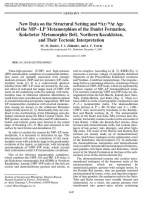Добрый день, Коллеги. Важное сообщение, просьба принять участие. Музей Ферсмана ищет помощь для реставрационных работ в помещении. Подробности по ссылке
New Data on the Structural Setting and 40Ar/39Ar Age of the MP–LP Metamorphism of the Daulet Formation, Kokchetav Metamorphic Belt, Northern Kazakhstan, and Their Tectonic Interpretation
Новые данные о структурном положении и возрасте 40Ar/39Ar метаморфизма MP–LP Даулетской свиты, Кокчетавский метаморфический пояс, Северный Казахстан, и их тектоническая интерпретация
Ultra-high-pressure (UHP) and high-pressure (HP) metamorphic complexes in continental subduc-tion zones are spatially associated with younger medium-pressure (MP) and low pressure (LP) meta-morphic rocks [1]. It is a controversial question whether these MP–LP rocks are formed by the contact effect of exhumed hot nappe stack of UHP–HP rocks on the underlying rocks (by analogy with meta-morphic base of obducted ophiolite allochthon) or result from later syncollisional metamorphism related to crustal thickening and granite magmatism. MP and LP metamorphic complexes with inverted metamor-phic zoning are known in the collisional Himalaya nappe-thrust system [2, 3]. Structurally, they are confined to the overthrusting of the Himalayas onto the Indian continent along the Main Central Thrust. The MP (garnet–kyanite–staurolite) and LP (sillimanite– biotite and biotite) rocks were formed at the initial stage of thrusting (25–15 Ma) and exhumed to the surface by later thrusts and denudation [3].
In order to explain the reasons for MP–LP meta-morphism, it is necessary to determine its age. This determination will allow a correlation of this meta-morphic event with a definite stage in the geodynamic evolution of the region, in particular, with retrograde metamorphism of UHP–HP rocks, which records their exhumation under LP metamorphic conditions.
One of the reference metamorphic complexes, which combines the UHP–HL and MP–LP rocks, is the Kokchetav metamorphic belt (KMB) in Northern Kazakhstan. Among UHP–HP rocks of this belt are coesite and diamondiferous gneisses and schists, as
Institute of Geology and Mineralogy, Siberian Branch, Russian Academy of Science, Novosibirsk, pr. Akad. Koptyuga 3, Novosibirsk, 630090 Russia e-mail: Misha@uiggm.nsc.ru
well as eclogites. According to [4, 5], KMB (Fig. 1) represents a tectonic collage of repeatedly deformed fragments of the Precambrian Kokchetav continent and Vendian–Cambrian megamelange. The megame-lange belt is a contrasting structure, consisting of slices and blocks of UHP–HP rocks, which are separated by tectonic nappes of MP–LP metamorphosed rocks. Five terranes containing UHP and HP rocks are distinguished within the belt: Barchi, Kumdy-Kol, Sulu-Tube, Enbek-Berlyk, and Kulet (Fig. 1). These ter-ranes differ in terms of petrographic composition and P–T–t metamorphic paths. The diamondiferous rocks formed at P = 40–70 kbar and T = 1100– 1200°C were recovered by boreholes in the Kumdy-Kol and Barchi terranes [4, 5]. The metamorphic rocks of the Kulet and Sulu-Tube terranes lack diamonds, but locally contain coesite (in the area south of Lake Kulet). Unlike the Kumdy-Kol terrane, these terranes lack metacarbonate rocks, but contain inter-layers of talc-garnet, talc–phengite, and other high-Mg rocks. The rocks of the Barchi and Kumdy-Kol terranes are mainly made up of metasedimentary rocks, which have analogues in the sedimentary cover of the Kokchetav microcontinent [5]. In particular, the diamondiferous metapelites and metacarbonate rocks could be metamorphosed analogues of bitumen-and graphite-rich black shales and dolomites, which occur in the Sharyk Formation at the base of the sedimentary cover of the microcontinent [6].<...>




